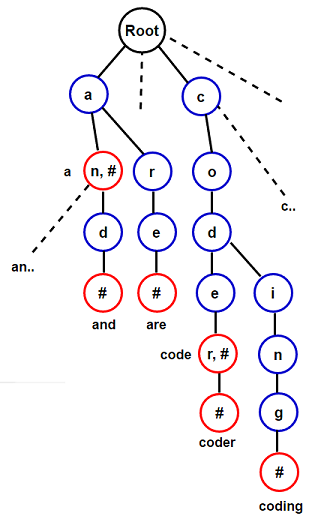Need a tree of chars for efficient prefix search? Try Tries!
What Makes Tries Special?
Imagine you’re typing a search query, and your phone magically completes the word for you. Or maybe you’ve mistyped something, and an app instantly suggests corrections. Behind the scenes of these seemingly simple features is a data structure that doesn’t get nearly enough credit—the Trie.
A Trie (pronounced “try”) is like a well-organized filing system for words. Unlike hash maps or binary search trees, Tries store characters in a way that naturally supports fast lookup, insertion, and prefix-based searching. But why does this matter? Because when it comes to text-heavy operations, Tries are often unbeatable.
A Peek Inside the Trie

Think of a Trie as a tree where each node represents a character. Words branch out as you traverse the structure, letter by letter. At the end of a valid word, a special marker (often a boolean flag) indicates completion.
Here’s a simple example:
(root)
/ | \
c b a
/ | \
a e p
/ | \
t e p (end)
(end) (end) \
l
\
e
(end)
This Trie stores the words “cat,” “bee,” and “app,” along with “apple.” Notice how prefixes are shared? That’s where the magic happens!
Why Tries Shine in Text Processing
Tries are particularly useful when dealing with large sets of words or searching for common prefixes. Here are some practical applications:
-
Autocomplete & Predictive Text: When you type “app,” a Trie can instantly suggest “apple” and “application” by following the stored characters.
-
Spell Checking & Correction: Tries make it easy to find words that are just one or two edits away, helping autocorrect do its job seamlessly.
-
Pattern Matching: Need to find all words that start with “pre”? A Trie can fetch them in a flash, no need for expensive regex operations.
-
IP Routing : Tries aren’t just for words—they’re also used in network routing tables for rapid IP lookup.
But Wait, Are Tries Always the Best Choice?
Tries are powerful, but they’re not a one-size-fits-all solution. Their biggest downside? Memory usage. Since each character needs its own node, Tries can become memory-hungry compared to hash-based approaches. If space is a concern, alternatives like Ternary Search Trees or compressed Tries (like Radix Trees) might be worth considering.
A Simple Trie Implementation in C++
class TrieNode{
public:
unordered_map<char, TrieNode*> children;
bool isEndOfWord;
TrieNode() {
isEndOfWord = false;
}
};
class Trie {
private:
TrieNode* root;
public:
Trie() {
root = new TrieNode();
}
void insert(string word) {
TrieNode* node = root;
for(char ch: word){
if(node->children.find(ch) == node->children.end()){
node->children[ch] = new TrieNode();
}
node = node->children[ch];
}
node->isEndOfWord = true;
}
bool search(string word) {
TrieNode* node = root;
for(char ch: word){
if(node->children.find(ch) == node->children.end()){
return false;
}
node = node->children[ch];
}
return node->isEndOfWord;
}
bool startsWith(string prefix) {
TrieNode* node = root;
for(char ch: prefix){
if(node->children.find(ch) == node->children.end()) return false;
node = node->children[ch];
}
return true;
}
};
The Verdict
Tries might not always be the first data structure that comes to mind, but when it comes to text processing, they’re a powerhouse. If you’re building anything that relies on efficient string lookups, autocomplete, or prefix-based searches, a Trie might just be your best friend.
Next time you type into a search bar and see instant suggestions, take a moment to appreciate the Trie working behind the scenes. It’s the unsung hero of text processing!
Enjoy Reading This Article?
Here are some more articles you might like to read next: